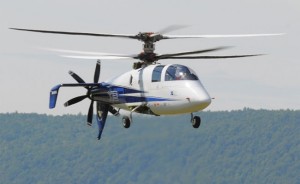
As it designs a speedy armed scout helicopter for future military needs, Sikorsky Aircraft Corp. is already looking ahead to far-larger helicopters mounted with its new “pusher prop” that can achieve far faster speeds than helicopters can achieve today ”“ including a version for general aviation.
Sikorsky is the largest employer in the Fairfield County area with more than 9,000 employees at its Stratford headquarters and satellite facilities. Parent United Technologies Corp. is based in Hartford.
At last month”™s AirVenture show in Oshkosh, Wis., a Sikorsky pilot revealed new versions on the drawing board of its X2 prototype aircraft, which made its final flight to the show after shattering a speed record last year that had stood since 1986. The X2 features stacked, counter-cyclical rotors; and a rear propeller mounted like that on an airplane to push it to faster speeds.
Sikorsky now envisions that aircraft as the S-97 Raider, which could carry two pilots and up to six passengers, while being armed for combat. Sikorsky pilot Kevin Bredenbeck, who flew the X2 at 290 mph last year, said Sikorsky would “probably start cutting metal” in August with the goal of completing two Raiders by early 2014 at the latest, even as its engineers consider a progression of larger helicopters featuring the same design that he says the company could build, eventually getting into the category of heavy-lift aircraft.
“It”™s the first stage,” Bredenbeck said. “You can see where potentially we are going in the next one: a Black Hawk cabin-class.”
Bredenbeck said Sikorsky is not confining the design to Pentagon use.
“We are focusing probably toward a military-first variant, but we want to get everybody exposed to what this can bring,” he said, singling out the Federal Aviation Administration.
Even as Sikorsky considers the X2”™s design for fast civilian use, rival Bell Helicopter reached a deal to sell AgustaWestland its interests in a commercial version of its V-22 Osprey tilt-rotor aircraft the companies were jointly developing. Dubbed the AW609, the aircraft is designed to take off like a helicopter and then swivel its wing-mounted rotors vertically to operate as propellers, with a maximum speed of about 315 mph. AgustaWestland is testing the aircraft in Arlington, Texas, and hopes to secure FAA approval to sell the aircraft in 2015.
In the second quarter, Sikorsky sales were up 6 percent from a year ago to nearly $1.8 billion, with the company recording a $277 million operating profit after shipping 70 helicopters. UTC recognized a $73 million gain from Sikorsky”™s “contribution of a business,” in its words, into a new venture in the United Arab Emirates.
Only the quarter before, Sikorsky warned that military sales appeared to be flattening. But due in part to commercial market and after-part sales, Sikorsky had its second-best quarter in the past 18 months, trailing only the $2.1 billion recorded in the fourth quarter last year.
Of the 70 aircraft Sikorsky sold in the second quarter, one was a maritime helicopter delivery to Canada under a program that has vexed Sikorsky as the company delayed delivery of a few of the aircraft into the current quarter. In previous calls, CFO Greg Hayes has said the company will lose $10 million or more on each of the initial Canadian helicopter shipments, but that UTC will still make a profit over the lifetime of the deal.
“We had great reception over at the Paris Air Show ”¦ from the foreign governments that are looking at this thing,” Hayes said. “These (Canadian) helicopters ”¦ they”™re going to cost a lot, but we”™re going to have a great, great aircraft when this is all done.”


















